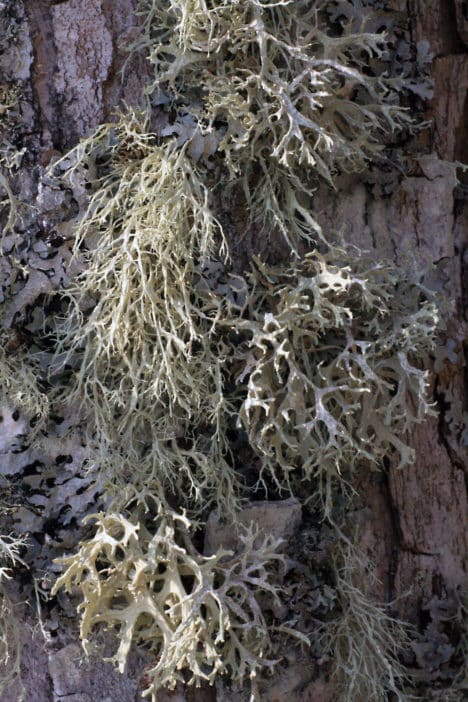Usnea Barbata Extract

Bearded lichens form a separate group within the Parmeliaceae family. Since ancient times, they have been considered extremely important medicinal plants, with the bearded lichen extract (Usnea barbata Extract) playing a significant role. The green to yellow looking lichen, popularly known as tree moss or old man’s beard, grows shrub-like and hanging from the bark of deciduous and coniferous trees. Scientifically, bearded lichen is a symbiotic community between an ascomycete fungus and a chlorophyte alga. Since bearded lichens basically require an acidic environment, they also only grow on trees with acidic bark. Depending on the environment, they can reach a length of ten centimeters to one meter. They are particularly fond of precipitation-rich humid locations and cold air areas. Lichens are very long-lived, they can live for several hundred, in many cases even several thousand years. That is why they are often used to determine the age of rocks.
Usnea barbata Extract and its ingredients
Usnea barbata extract contains mainly stable, mucilage-forming sugar components and bitter lichen acids. One of these lichen acids is usnic acid, which is effective against various types of bacteria and fungi. It shows particular antibiotic activity against mycobacteria, Streptococcus aureus and methicillin-resistant staphylococci. It also contains tannins and vitamin C. Since the bearded lichen even has a fairly high content of vitamin C, it is virtually predestined for applications on superficial wounds. The vitamin is known to promote the formation of new connective tissue and stimulate the immune system. The components of bearded lichen also have a very high degree of effectiveness against tubercle bacilli and gram-positive germs.
Beard lichen extract and its medicinal effectiveness
Bearded lichen is often prepared as a tea. In this variant, it alleviates gastrointestinal disorders just as efficiently as bilious complaints. Lozenges with Usnea barbata extract help against tonsillitis, sore throat and pharyngitis. The bitter substances contained in the lichen act like a protective film on the mucous membrane of the mouth and throat, effectively treating the inflammation. Preparations with the extract of the beard lichen can also be used very well for poultices and as a wound dressing. Applied externally, the extract disinfects open wounds and promotes the wound healing process. The formation of new tissue is stimulated. A beard lichen tincture can often even heal abscesses and boils. Also as a tincture, beard lichen ensures that toxins (for example, heavy metals and pesticides) stored in the body’s own fat are efficiently eliminated.
Nevertheless, there is one small disadvantage: many beard lichen products contain high-proof alcohol. Dry alcoholics or people with an alcohol problem should therefore refrain from using preparations containing Usnea barbata extract and alcohol. The same applies to children under twelve years of age and patients with an existing liver disease.
Usnea barbata extract in cosmetics
In cosmetics, beard lichen extract is now highly valued. Skin damage such as sunburn caused by an excessive dose of UV light can be significantly alleviated or even cured with an appropriate bath or poultice with Usnea barbata Extract. In addition, the extract thoroughly addresses skin blemishes, pimples, acne and inflammatory skin conditions. Rosacea can also be treated well with beard lichen extract. An anti-proliferative (cell division inhibiting) effect has also been successfully demonstrated. In addition, beard lichen is a completely natural deodorant that inhibits the formation of odors. Thanks to its antimicrobial properties, beard lichen is also popularly and successfully used against thread fungus and athlete’s foot.
In addition to this positive properties, bearded lichen is considered a plant with a relatively low irritant potential, which means that it is usually very well tolerated. To date, Usnea barbata Extract is not known to have any significant side effects or interactions with medications. Another positive aspect is its gratifyingly low allergenicity.
Fact Sheet Beard Lichen Extract
INCI: Usnea barbata (Lichen) Extract
Origin/Family: Parmeliaceae (lichen)
Properties: yellow extract with a neutral scent
Cosmetic use: supports microbial stabilization of cosmetic formulations, has a deodorizing effect, effective in skin infections and in anti-dandruff preparations.
Fact Sheet Usnic Acid
Definition: Component in Usnea barbata extract.
Alternative name: 2,6-diacetyl-7,9-dihydroxy-8,9b-dimethyl- 1,3(2H,9bH)-dibenzofurandione
CAS number: 7562-61-0
EC number: 231-456-0
Molecular Formula: C18H16O7
Melting point: 201 to 202 degrees Celsius
High quality cosmetics with Usnea barbata Extract
Usnea barbata Extract is a highly effective ingredient for sophisticated ointments, creams, tinctures, bath additives and anti-dandruff preparations. It is as effective for blemished skin, superficial lesions and acne as it is as a natural deodorant ingredient. Its function as a co-preservative component in cosmetic products should also be mentioned. Cosmacon will gladly integrate the extract of beard lichen into your formulations and support you in developing an appropriate formulation. Ask us, we will be happy to advise you!
Sources:
Evaluation of Anticancer and Antioxidant Activity of a Commercially Available CO2 Supercritical Extract of Old Man’s Beard (Usnea barbata).; Zugic A, Jeremic I, Isakovic A, Arsic I, Savic S, Tadic V. PLoS One. 2016 Jan 8;11(1):e0146342.
Phenolic Secondary Metabolites and Antiradical and Antibacterial Activities of Different Extracts of Usnea barbata (L.).; Popovici, V., Bucur, L., Gîrd, C. E., Popescu, A., Matei, E., Cozaru, G. C., Badea, V. (2022). a. Pharmaceuticals, 15(7), 829.
Evaluation of the Cytotoxic Activity of the Usnea barbata (L.) F. H. Wigg Dry Extract.; Molecules. 2020 Apr 17;25(8):1865.